How to turn off the gas boiler for conservation: methods, detailed instructions and safety requirements
Modern gas equipment is attractive because it does not require frequent repairs and any serious maintenance. All care work is carried out by representatives of the gas service with which the owners of the house conclude an agreement. But when there is no need for heating or water heating, it is not difficult to turn off the boiler with your own hands, right?
Why not follow the procedure for disconnecting the equipment yourself, and not pay for the call of a specialist? In this article, we will analyze all the subtleties of this process - we will consider information on how to turn off the gas boiler, while observing the safety rules.
Especially for those who are used to doing household chores with their own hands, we offer 4 ways to preserve the boiler, which will reliably protect the heating system during downtime. After all, it’s not enough just to dial a combination of buttons to turn off the unit - it is necessary to properly preserve all connected equipment. Let us consider in more detail how to do this better.
The content of the article:
Reasons for shutting down the gas boiler
A gas boiler is the real "heart" of a private home. It provides the building with heat, and dual circuit models - and hot water.
Thanks to the electronic filling, the main processes - switching on, switching off, switching to another mode, temperature adjustment - are carried out automatically, without human intervention. The owner needs to set the program by pressing, depending on the manufacturer's instructions, the corresponding buttons or keys.
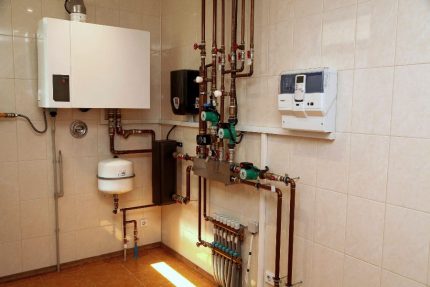
Shutdown may be necessary for various reasons:
- moving to another place of residence;
- seasonal shutdown for the warm period;
- emergency stop due to boiler breakdown and inability to quickly repair or replace;
- scheduled stop for maintenance - removing deposits, flushing the inner circuit or cleaning from soot;
- connection of other heating or hot water equipment;
- disabling one of the functions - for example, heating, etc.
Most often, you need to turn off the heating. For this, the operation of 1-circuit units is completely stopped, and for 2-circuit units, only one line is blocked - the heating line.
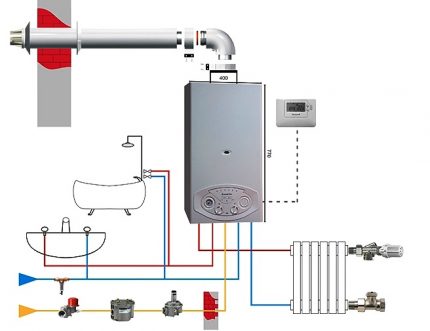
Many modern models have the option of switching to summer mode. At the same time, the boilers do not fail - they also continue to work, maintaining the optimum temperature and keeping the system “ready” for active start at any time.
In the summer, especially in the northern regions, there are also cold snap and even freezing, so the existing equipment is useful.
Step-by-step shutdown instructions
If the gas burner does not light up or goes out immediately after switching on, it often shuts off for unexplained reasons, pops occur, the temperature of the water in the circuit does not correspond to the indicators, a noise uncharacteristic for the unit is operating, water has leaked in the housing, pressure has dropped - the equipment should be turned off immediately .
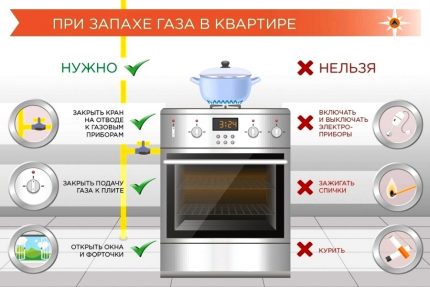
The shutdown procedure for boilers is different, but the main steps are similar.
Consider the example of the Baxi model, how to properly and quickly turn off the gas boiler:
- Turn off the fuel supply by turning the gas shut-off valve.
- Leave the fan running for another 15 minutes.
- Turn off the fan, stop the smoke exhaust system.
- Wait until the temperature in the circuit is below +30 ° C, turn off circulation pump.
- Turn off the power by turning the switch to the “Off”, “0” or other position specified by the manufacturer.
- Perform conservation work on the boiler and related equipment.
Not all systems drain water completely. Some manufacturers recommend adding fluid to the coolant that prevents the formation of lime deposits. The most effective for household communications recognized propylene glycol or antifreeze with special additives.
In the event of force majeure, you have to quickly figure out how to quickly turn off the gas boiler, while maintaining the system’s performance and not harming yourself. Next, we consider special cases.
Sometimes, when overheating or lack of traction, the boiler automatically shuts off. It stops working, respectively, the heating of the house is suspended. If auto shutdown occurs very often, 5 times in 15 minutes, you should shut off the gas and contact the after-sales service.

Problems in the smoke exhaust system also automatically stop the unit. Usually it gives an error on the display and stops working for 12-15 minutes, and then turns on again. If the problems are not resolved during this time, auto-shutdown occurs again - and so on until the problem is completely resolved. To clean the gas outlet, shut off the gas and turn off the boiler.
Many boilers are protected against freezing. automation. Protection works if the boiler sensors are connected to the power supply, the system has normal pressure and gas is not shut off.
In case of any malfunction, if the temperature of the coolant in the circuit drops below + 8-10 ° C (depending on the model), the operation of the unit is suspended. In extreme cases, if you can’t quickly cope with the circumstances - turn on the boiler and establish its functioning - you can try to drain the water so as not to rupture the pipes and parts of the unit.
Methods of preservation of gas boilers
Consider the main methods of preservation of heating equipment, but with one caveat - not everyone uses home maintenance. Some of the methods are more suitable for equipment installed in production plants.
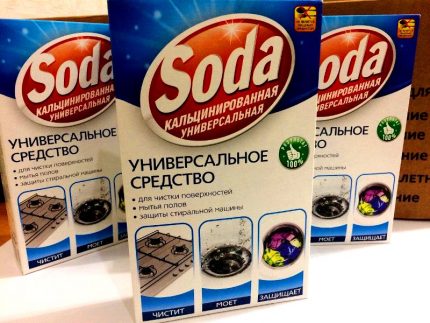
The heating circuit conservation process is preceded by a preparatory stage, which includes several points:
- Disconnecting the boiler from the gas main and central water supply, installing plugs. If water is supplied by the pumping station, stop the pump.
- Removing water or other coolant from the system.
- Limescale cleaning of internal surfaces.
- Flushing boiler parts and circuit.
Professional cleaning of calcium deposits can only be carried out by specialists - and the service organization has such a service. The two most effective and easiest ways to descale are chemical, mechanical (manual cleaning), but the first is recognized as the most effective.
The internal parts of the boiler, on which large deposits have appeared, are ground with a power tool, and scale in hard-to-reach places is removed manually, with brushes or scrapers.
Method # 1 - dry stop
Dry preservation is carried out at the production site, usually for maintenance activities or during a scheduled inspection, when a shutdown of capacities is required for up to 30 days. It consists in the complete liberation of equipment and pipelines from liquid and in further drying.
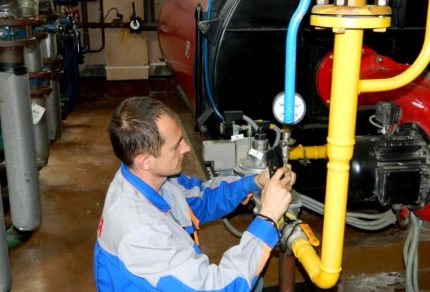
Procedure:
- Naturally coolant coolant.
- Boiler shutdown.
- The displacement of a liquid under a pressure of 0.8-1.0 MPa.
- Drying the system naturally or by ventilation.
- Installation in collectors of pallets with desiccants - quicklime or calcium chloride in grains.
- Closing the furnace and gas duct, plugs - complete sealing of the system.
At home, water is drained through special taps installed in the lower part of the pipeline. Then carry out repair or maintenance work, leave the equipment in a "dry" state until the next heating season.
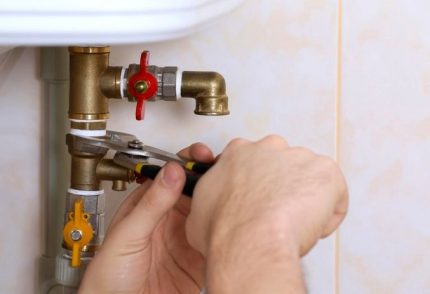
Converse coolant filling produced using a pump. The heating function is connected only after the pipeline is completely filled with water, circulation check and diagnostics.
This method is the only correct one if it is necessary to suspend the boiler for the winter or for an even longer period.
Method # 2 - wet preservation option
I use wet preservation if you need to stop the boiler for a short period. The main goal is to keep the equipment in working condition, protect it from corrosion, and prevent oxygen from entering the circuit.

For regions with severe frosts, liquids that do not freeze at low temperatures are used. For example, concentrated antifreeze is in a liquid state up to -60 ° C. So that the substance does not thicken, it is diluted with water. But you need to remember that the freezing temperature of an aqueous solution rises.
Antifreeze has other disadvantages:
- "Eats" rubber;
- has a high degree of fluidity;
- does not tolerate overheating - turns into acid;
- expensive.
Instead of antifreeze, a solution of sodium sulfate is used at the rate of 10 g / liter of water. The liquid poured into the system is heated to displace air, and then all openings are hermetically sealed. To pump water into the circuit, a pressure pump is used.
Method # 3 - gas preservation
For private houses, the gas conservation method is not used, as this requires special equipment and professional skills.
The essence of the technology is that gas is launched into the pipes, which, when in contact with metal, unlike oxygen, does not cause corrosion. These gases include argon, ammonia, helium, nitrogen.
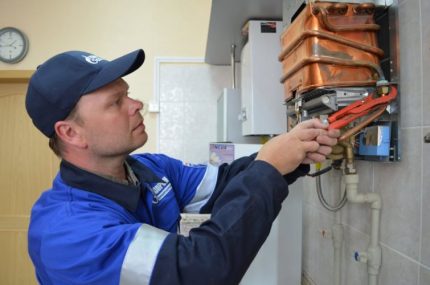
The conservation process is complex and is carried out in several stages:
- the system is washed with deaerated water;
- connect the gas cylinder and gearboxcontrolling pressure;
- fill the circuit with gas displacing water;
- close the drain valve;
- at a rate of 0.013 MPa, the gas supply is stopped;
- block the pipe, turn off the cylinder.
The main condition for gas conservation is lack of air in the systemTherefore, throughout the entire downtime, it is necessary to monitor its tightness.
Method # 4 - applying excess pressure
Conservation technology under high pressure is usually used in enterprises where all conditions are created for this. It is used for hot water and steam equipment.
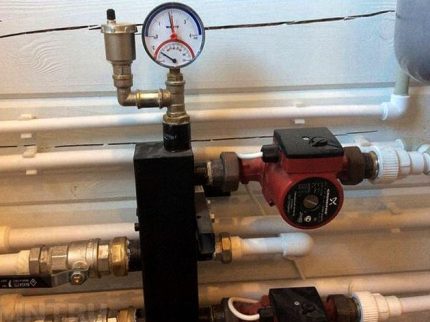
The overpressure method is suitable if it is necessary to suspend the operation of a gas boiler for a short period - up to 10 days. Usually, during this period, repairs are carried out that are not related to water-heating equipment.
What rules do you need to follow?
When carrying out activities for the conservation of boilers in production, they are guided by the requirements set out in RD 34.20.591-97 "Guidelines for the conservation of thermomechanical equipment."
The same standards should be observed for owners of equipment installed in private homes.

What you need to remember if you decide to preserve heating or water heating equipment yourself:
- The gas must be shut off before any repair work. The main crane is installed at the gas inlet to the house.
- Even the slightest ingress of oxygen into the system will cause corrosion of the boiler parts and the pipeline, so you need to choose one of the conservation methods and follow it strictly according to the instructions.
- When working with chemical reagents, it is necessary to protect parts of the body with tight clothing, wear comfortable shoes, gloves and a mask.
- To keep the pipes and units of the unit in working condition, it is necessary to observe the dosage when diluting concentrated formulations and dry chemicals.
- Work with explosive or combustible substances may only be carried out by specialists.
- At the end of the work, it is necessary to disconnect the power supply of additional equipment - for example, a pump.
The above rules must be observed to protect your own health and preserve the equipment.
After a long standstill of the heating and water heating system, re-preservation will be required - a process that also requires compliance with certain rules.
Conclusions and useful video on the topic
Some boilers are very easy to turn off:
On the transfer of the modern model to summer mode and possible errors:
One way to drain the heating system:
If you leave home for a long time, you must not drop gas equipment without a preliminary stop. In the absence of the owners, an unforeseen situation may occur that can deprive you not only of the heating system, but also of the house. It is better to consult with specialists in advance how to turn off the heating and stop the gas boiler, and act according to the recommendations.
Qualified cleaning and conservation can only be carried out by professionals. Automatic shutdown or transfer to a more suitable mode can be performed independently, according to the manufacturer’s instructions, but only if you leave the house for a short time.
Do you have questions in the process of self-preservation of gas equipment? Ask for advice from our experts and other site visitors, participate in the discussion - the comment form is located below.

 Why a gas boiler often turns on and off: the causes of malfunctions and their solutions
Why a gas boiler often turns on and off: the causes of malfunctions and their solutions 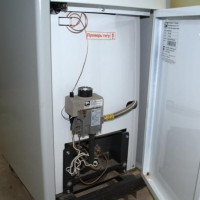 The Lemax gas boiler does not turn on: frequent breakdowns and ways to deal with them
The Lemax gas boiler does not turn on: frequent breakdowns and ways to deal with them 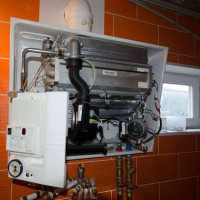 Condensing gas boiler: specifics of action, pros and cons + difference from classic models
Condensing gas boiler: specifics of action, pros and cons + difference from classic models 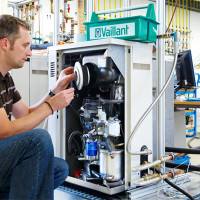 Why the gas boiler is noisy: why the unit is buzzing, clicking, whistling, clapping + how to fight
Why the gas boiler is noisy: why the unit is buzzing, clicking, whistling, clapping + how to fight 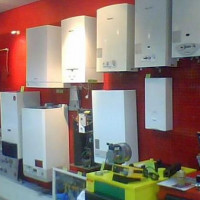 What is better double-circuit or single-circuit gas boiler: features of the device and operation
What is better double-circuit or single-circuit gas boiler: features of the device and operation 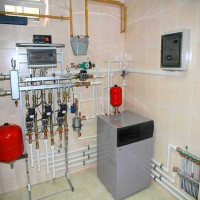 What to do if the gas boiler blows in the wind: causes of the boiler attenuation and methods for resolving the problem
What to do if the gas boiler blows in the wind: causes of the boiler attenuation and methods for resolving the problem  How much does it cost to connect gas to a private house: the price of organizing gas supply
How much does it cost to connect gas to a private house: the price of organizing gas supply  The best washing machines with dryer: model rating and customer tips
The best washing machines with dryer: model rating and customer tips  What is the color temperature of light and the nuances of choosing the temperature of the lamps to suit your needs
What is the color temperature of light and the nuances of choosing the temperature of the lamps to suit your needs  Replacement of a geyser in an apartment: replacement paperwork + basic norms and requirements
Replacement of a geyser in an apartment: replacement paperwork + basic norms and requirements